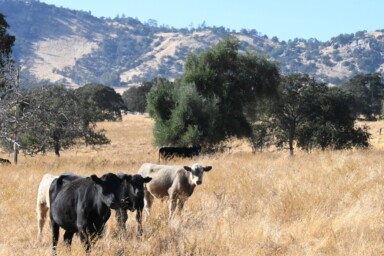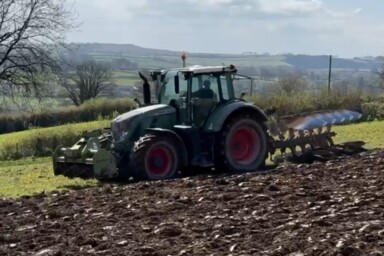Arable farming systems across South Africa are going through a change. Forced by a variable climate and financial pressure, regenerative farming models are increasingly being implemented on cropping, dairy and beef operations as a result. Ethical motivations and issues of family succession are also reasons for adopting the principles of Regenerative Agriculture (RA).
Recent research that I conducted in Northern Kwa-Zulu Natal and the Eastern Free State in South Africa explored the RA concept and investigated how widely it is being applied and why. The initial line of questioning posed to 59 farmers across this part of South Africa focused on weather data, its utility and how farmers are handling the climate-associated challenges. For these farmers, climate change is their primary concern, over and above political and economic issues. Of the 59 farmers who participated in the study, 42 were employing the principles of RA, to some extent, to mitigate the effects of variable and extreme weather. Farm sizes ranged from 500 to 25,000 acres and included combinations of dairy, ranching and cropping operations, with game, fruit, forestry and vegetable production often practised on diversified farms.
Across this region of South Africa climate patterns are changing. Rainfall is more intense and isolated with dry spells occurring more and more regularly. The number of days with temperature highs of over 30 degrees centigrade is rising, and the winter frosts which control ticks and the diseases they carry are less regular. Unreliable rainfall is, however, the chief challenge. One farmer stated that in the 2016/2017 season, he received a third of his annual rainfall in less that 48 hours. This has severe consequences for arable farms which need to maximise the capture and storage of rainfall as it arrives.
As a result of changing weather patterns, capturing rainfall where it lands and retaining it in the soil as green water has become of paramount importance to both cropping and ranching systems. The primary determinants of rainfall infiltration rates are land cover and soil health, and this is why farmers are turning to the regenerative model. RA preaches almost constant diverse vegetative cover on the surface which slows runoff and encourages infiltration, while healthy, living and structurally intact soils have a greater capacity to hold moisture in the root zone. Rebuilding the structure of soils that had been routinely pulverised by heavy tillage for decades, became the first step taken by farmers experimenting with the RA concept. A zero-till approach and the use of multi-species cover crops are now seen by farmers as critical in efforts to combat a variable climate; however, economic forces have driven the regenerative agenda further.
Since 1994 agricultural subsidies have been steadily withdrawn in South Africa to a point where farmers currently receive almost no government assistance whatsoever. While this has led to a decline in the total number of farmers, productivity and efficiency have increased markedly. In essence, it has been a case of survival of the fittest with the most capable farmers, the majority of which still run family farms, buying out those around them who failed to adapt to declining state support. At present, financial pressure is higher than ever with the rising costs of agricultural inputs and depressed global food prices. Regenerative agriculture has helped farmers reduce production costs.
With less or no soil disturbance, diesel bills are being slashed as life returns to the soil. At the time of interview, one farmer was selling off his 400+KW tractors in favour of machines half as powerful. “To work my soil, my tractors used to work in first gear, and I had to use a pick to break the surface. Now they fly along and I can use my hand to dig out clods of living soil.” The integration of livestock into cropping regimes, often using a mob grazing model, along with diverse covers and near permanent soil cover is re-injecting organic matter into the soil and optimising the liquid carbon pathways that feed the microbial communities helping make nutrients available to the plant. This can result in a declining need for synthetic fertilisers, greater moisture availability and critically, substantial financial savings.
While min-till has been the defining characteristic of the Conservation Agriculture (CA) paradigm for decades, combining it with year-round diverse ground cover and livestock is a relatively new phenomenon in this part of the world. Gabe Brown’s operations in Bismarck, North Dakota were often sighted as the inspiration for this trend in South Africa. It appears that education about the RA model has not come down through formal channels. Experience and ideas have instead been circulated informally through farming communities by word of mouth. An extraordinary characteristic of farmers in these parts of South Africa is their willingness to share knowledge and experience. As little formal research is investigating the topic, experimentation and the sharing of results is key.
The experimentation aspect is well worth dwelling on. Each farmer included in the study has had to experiment with the principles of the concept in his or her own physical context. Geographies were highly variable in the study area and so tailoring the adoption of RA to specific contexts and allowing time and space for experimentation is vital. For example, at one point a farmer was using a 31 plant species mix in his multi- species dairy pasture, but through experimentation and careful monitoring, he found an optimal mix of 14 species for his lands. For cropping systems, it was repeatedly stated that it took four to ten years for yields to recover to pre no-till levels as life and structure in the soil was regenerated. The variation in experience required farmers to adopt different implementation strategies, with some slowly changing practice one field per year while others opted a wholesale change in their farming systems far more rapidly.
The final point to make concerning RA adoption in South Africa is to do with succession and ethics. A number of those interviewed stated that they wanted to hand down viable farms to their children and the next generation. There is a general consensus that conventional agricultural systems are detrimental to environmental functioning and are not compatible with sustainable soil management and biodiversity. Fortunately, RA does appear to be an alternative that could mitigate the climatic and financial pressures being applied to farmers while also meeting environmental agendas.
One farmer commented, “My greatest satisfaction has come from wildlife returning to the farm en masse, from dung beetles to sparrow hawks. This has only happened by seeing the farm as part of a wider agro-ecosystem.”
There are challenges to adopting this form of farming. Farmer experience indicates that as regenerative agriculture is adopted, yields will initially decline and then recover to, or exceed, previous levels over a four- to ten-year period as the soil recovers. This initial drop in production is a cost that needs to be absorbed. A greater spraying requirement, to terminate cover crops and control weeds, is a further obstacle that has yet to be fully negotiated. Rolling, crimping and mowing are developing alternatives to spraying. However, it is abundantly clear that farming systems respond to these challenges and that, as custodians of the vast majority of our landscapes, farmers can maintain livelihoods while positively interacting with the ecosystems that supply the goods and services which agricultural systems ultimately rely on.






